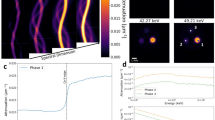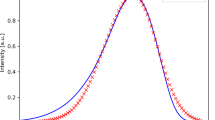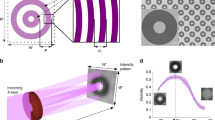Abstract
We report Fourier transform infrared spectro-microtomography, a nondestructive three-dimensional imaging approach that reveals the distribution of distinctive chemical compositions throughout an intact biological or materials sample. The method combines mid-infrared absorption contrast with computed tomographic data acquisition and reconstruction to enhance chemical and morphological localization by determining a complete infrared spectrum for every voxel (millions of spectra determined per sample).
This is a preview of subscription content, access via your institution
Access options
Subscribe to this journal
Receive 12 print issues and online access
$259.00 per year
only $21.58 per issue
Buy this article
- Purchase on Springer Link
- Instant access to full article PDF
Prices may be subject to local taxes which are calculated during checkout




Similar content being viewed by others
References
Holman, H.-Y.N., Bechtel, H.A., Hao, Z. & Martin, M.C. Anal. Chem. 82, 8757–8765 (2010).
Miller, L.M. & Dumas, P. Biomembranes 1758, 846–857 (2006).
Kastyak-Ibrahim, M.Z. et al. Neuroimage 60, 376–383 (2012).
Hazen, T.C. et al. Science 330, 204–208 (2010).
Nasse, M.J. et al. Nat. Methods 8, 413–416 (2011).
Pampaloni, F., Reynaud, E.G. & Stelzer, E.H.K. Nat. Rev. Mol. Cell Biol. 8, 839–845 (2007).
Guilhaumou, N., Dumas, P., Carr, G.L. & Williams, G.P. Appl. Spectrosc. 52, 1029–1034 (1998).
Jamme, F., Lagarde, B., Giuliani, A., Garcia, G. & Mercury, L. J. Phys. Conf. Ser. 425, 142002 (2013).
McNaughton, D., Wood, B.R., Cox, T.C., Drenckhahn, J.-D. & Bambery, K.R. in Infrared and Raman Spectroscopic Imaging (eds. Salzer, R. & Siesler, H.W.) 203–223 (Wiley, 2009).
Stone, N. et al. Chem. Sci. 2, 776–780 (2011).
Holman, H.-Y.N., Martin, M.C. & McKinney, W.R. J. Biol. Phys. 29, 275–286 (2003).
Herman, G.T Fundamentals of Computerized Tomography: Image Reconstruction from Projection 2nd edn. (Springer, 2010).
Mizutani, R. et al. in Microscopy: Science, Technology, Applications and Education. Vol. 1 (eds. Mendez-Vilas, A. & Diaz, J.) 379–386 (Formatex Research Centre, 2010).
de Jonge, M.D. et al. Proc. Natl. Acad. Sci. USA 107, 15676–15680 (2010).
Illman, B.L. & Dowd, B.A. in Developments in X-Ray Tomography II Vol. 3772 (ed. Bonse, U.), 198–204 (SPIE, 1999).
Lacayo, C.I. et al. Plant Physiol. 154, 121–133 (2010).
Fukuda, H. & Komamine, A. Plant Physiol. 65, 57–60 (1980).
Buschke, D.G., Eliceiri, K.W. & Ogle, B.M. in Stem Cell-Based Tissue Repair (ed. Goradetsky, R.S.) 55–140 (RSC, 2010).
Pijanka, J.K. et al. Analyst (Lond.) 135, 3126–3132 (2010).
Cao, J. et al. J. Biophotonics published online, 10.1002/jbio.201200217 (25 April 2013).
Ye, D. et al. Analyst (Lond.) 137, 4774–4784 (2012).
Dottori, M., Leung, J., Turnley, A.M. & Pebay, A. Stem Cells 26, 1146–1154 (2008).
Sánchez-Sánchez, R. et al. Dev. Dyn. 241, 953–964 (2012).
Krishnaswami, K., Qiao, H., Bernacki, B.E. & Anheier, N.C. Jr. in Laser Technology for Defense and Security V Vol. 7325 (eds. Dubinskii, M. & Post, S.G.), 73250Z (SPIE, 2009).
Nallala, J. et al. J. Biomed. Opt. 17, 116013 (2012).
Hirschmugl, C.J. & Gough, K.M. Appl. Spectrosc. 66, 475–491 (2012).
Levenson, E., Lerch, P. & Martin, M.C. J. Synchrotron Radiat. 15, 323–328 (2008).
Mattson, E.C., Unger, M., Manandhar, B., Alavi, Z. & Hirschmugl, C.J. J. Phys. Conf. Ser. 425, 142001 (2013).
Dumas, P., Jamin, N., Teillaud, J.L., Miller, L.M. & Beccard, B. Faraday Discuss. 126, 289–302 (2004).
Martin, M.C. & Dumas, P. in Spectroscopic Properties of Inorganic and Organometallic Compounds: Techniques, Materials and Applications Vol. 43 (eds. Yarwood, J., Douthwaite, R. & Duckett, S.B.) 141–165 (Royal Society of Chemistry, 2012).
Martin, M.C., Schade, U., Lerch, P. & Dumas, P. Trends Analyt. Chem. 29, 453–463 (2010).
Crowther, R., DeRosier, D.J. & Klug, A. Proc. R. Soc. Lond. A Math. Phys. Sci. 317, 319–340 (1970).
Fessler, J.A., Ficaro, E.P., Clinthorne, N.H. & Lange, K. IEEE Trans. Med. Imaging 16, 166–175 (1997).
Erdogan, H. & Fessler, J.A. IEEE Trans. Med. Imaging 18, 801–814 (1999).
Erdogan, H. & Fessler, J.A. Phys. Med. Biol. 44, 2835–2851 (1999).
Fessler, J.A. & Rogers, W.L. IEEE Trans. Image Process. 5, 1346–1358 (1996).
Stayman, J.W. & Fessler, J.A. IEEE Trans. Med. Imaging 19, 601–615 (2000).
Ying, Q.-L., Nichols, J., Chambers, I. & Smith, A. Cell 115, 281–292 (2003).
Maltsev, V.A., Rohwedel, J., Hescheler, J. & Wobus, A.M. Mech. Dev. 44, 41–50 (1993).
Castro, J.M. & Dingwell, D.B. Nature 461, 780–783 (2009).
Castro, J.M., Manga, M. & Martin, M.C. Geophys. Res. Lett. 32, L21307 (2005).
Acknowledgements
Thanks to K. Krueger, M. Fisher and G. Rogers for outstanding machining skills and technical support. We also thank D. Ron for assistance on the spectral extractions. This work is based on research conducted at the IRENI beamline, whose construction and development was supported by the US National Science Foundation by award MRI-0619759. This work was supported by the US National Science Foundation under grant CHE-1112433. The ALS is supported by the Director, Office of Science, Office of Basic Energy Sciences, US Department of Energy under contract no. DE-AC02-05CH11231. The SRC is primarily funded by the University of Wisconsin–Madison, with supplemental support from facility users and the University of Wisconsin–Milwaukee.
Author information
Authors and Affiliations
Contributions
M.C.M. and C.J.H. conceived of the technique and led the project. C.D.-B. wrote automated data analysis code and carried out some of the experiments. M.J.N. wrote scripts to automate the data collection at IRENI. M.U. and J.S. helped perform all experiments. D.Y.P. provided tomographic reconstruction algorithms and expert advice on setting up the experiments. H.A.B. provided optical mount expertise and assistance with analysis codes. B.I. provided Populus samples and helped perform experiments and analysis of these samples. J.M.C. provided the volcanic samples and expertise for their analysis. M.K. provided the Zinnia samples and expertise for their analysis. D.B. and B.O. provided embryoid body colony samples and expertise for their analysis. All authors helped with writing this paper.
Corresponding authors
Ethics declarations
Competing interests
The authors declare no competing financial interests.
Supplementary information
Supplementary Text and Figures
Supplementary Figures 1–5 and Supplementary Note (PDF 698 kb)
Tomographic reconstruction of a Zinnia elegans tracheary element inside a polyimide microloop holder shown in Figure 1
The red color shows the reconstruction of the integrated intensity from the 2356.7–2376.0 cm−1 spectral region, where only the sharp edges of the microloop are visualized. After a little time, the blue-green colors are turned on that show the reconstruction of the 3317–3340 cm−1 spectral region associated with O-H stretching. The parallel secondary cell wall thickenings of the Zinnia elegans are now clearly visualized. (MOV 331 kb)
3D reconstruction of a Populus wood sample in Figure 2, shown rotating
The brown colors are reconstructed intensities of hydrocarbon stretching absorption modes in the 2804–3023 cm−1 spectral range. The blue-green colors are associated with holocellulose (1689–1781 cm−1). (MOV 1769 kb)
Movie of the full tomographic reconstructions obtained from an intact human hair from Figure 3 showing absorptions of protein (red) and phospholipid (blue-green)
The medulla is observed to have little protein as we see the protein reconstruction is indeed hollow, but it instead has higher concentrations of phospholipids. (MOV 620 kb)
Movie of the full tomographic reconstructions obtained from mouse stem cells from Figure 4 showing absorptions of protein (blue-red) and lipids (yellow-brown)
The movie starts showing on the protein distribution, then the lipids turn on and we see the overlapping distributions, and finally the proteins turn off to show the lipid distribution. (MOV 2990 kb)
Video showing the tomographic reconstruction of the integrated absorption in the 1573–1654 cm−1 spectral range for a polyimide microloop
Static images from this movie are shown in the top row of Supplementary Figure 2. (MOV 722 kb)
Video of the reconstructed volcanic glass sample shown in Supplementary Figures 4 and 5
The red-brown colors show the 1790 cm−1 absorptive regions, and the blue-green colors are the 3494 cm−1 absorptive regions superimposed on each other. The blue-green is dominated by water absorptions, (due to the combined H2O and OH stretching vibrations), whereas the red-brown regions are predominately the edge of the strong silicate glass absorption. The white space between has low absorbance at both spectral regions. (MOV 1102 kb)
Rights and permissions
About this article
Cite this article
Martin, M., Dabat-Blondeau, C., Unger, M. et al. 3D spectral imaging with synchrotron Fourier transform infrared spectro-microtomography. Nat Methods 10, 861–864 (2013). https://doi.org/10.1038/nmeth.2596
Received:
Accepted:
Published:
Issue Date:
DOI: https://doi.org/10.1038/nmeth.2596
This article is cited by
-
Infrared spectroscopic laser scanning confocal microscopy for whole-slide chemical imaging
Nature Communications (2023)
-
Mid-infrared single-photon 3D imaging
Light: Science & Applications (2023)
-
Small grains from Ryugu: handling and analysis pipeline for infrared synchrotron microspectroscopy
Earth, Planets and Space (2023)
-
Deep learning-enabled Inference of 3D molecular absorption distribution of biological cells from IR spectra
Communications Chemistry (2022)
-
3D infrared thermospectroscopic imaging
Scientific Reports (2020)



